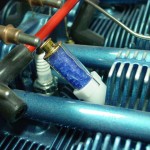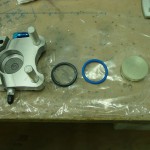Pickle me
Hours: 1.9 | Posted in Engine, Gear & FairingsIt’s been a but more than a year since my engine was built, and the protections applied at the build shop were said to be good for 12 months. I’ve been careful not to turn the engine, and have kept it’s openings mostly plugged, but I asked the kind folks who built the engine up at Aero Sport Power what measures I should take to prolong the preservation, given that it will likely be several more months before the fires are lit. Having procured the necessary items, I carried out their recommendation tonight:
- Pour 3 gallons of oil into the crankcase. They said this could be automotive oil, as it’s only there to cover and protect, not lubricate for flight. I put in conventional (non synthetic) Valvoline.
- Cap off the breather and exhaust stacks. I had a plug that fit into the breather hose, and I wrapped the stacks in plastic & tape, since I don’t have any plugs that large.
- Cap off the intake; this is already done, before I started doing any fiberglass work on the FAB & intake scoop.
- Insert dehydrator plugs and keep them dry. I looked around and found some that the crystals can be taken out of and dried. Make sure to ask that, as there are several places selling 14mm ones that are sealed, alongside the regular reusable 18mm versions.
I’ve been doing final reading on brake fluid & seals, and I decided to change out the caliper O-rings, since the stock Buna-N ones will deform in the 250* range. There have been cases of brake fires on RV’s and similar aircraft before, so many guys are replacing the 5606 fluid (flash point in the 200′s) with the more modern 83282 (flash point in the mid 400′s). Synthetic ATF is another option, which has specs similar to that of the 83282. It’s also become common to change out the O-rings with Viton, which is rated to 400*. The downside to Viton is it’s poor low-temperature performance (-15*). Since I do plan/hope to fly in the winter, I found some flourosilicone O-rings at McMaster, which have the same high-temp rating as Viton, but are also rated to -75. (They’re listed under “military specification o-rings,” p/n 8333T255)… a little pricey at $6.25 for a 2-pack, but that’s small potatoes.
The install couldn’t be easier: remove the caliper, pop out the piston, remove the old O-ring, clean up the piston & bore, lube the O-ring and insert it, then slide the piston back in place and re-assemble. Done.
Finally, the mixture linkage has been bugging me for awhile; even with the higher hole I drilled in the quadrant lever, it wasn’t confidently hitting the stops on the fuel servo before hitting the end of the quadrant throw. (Yes, I tried a bunch of different arm angles.) To solve that, I pulled the mixture arm off and drilled another bolt hole a bit higher than the existing one, then reinstalled. Works perfectly now, the stops are hit before the quadrant lever runs out of travel, and the throw matches that of the throttle lever.



